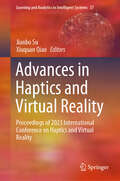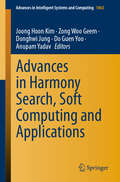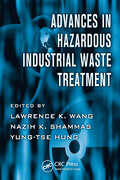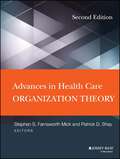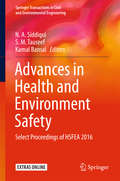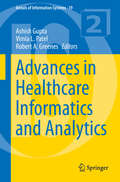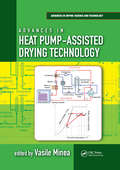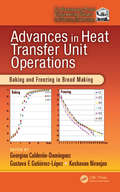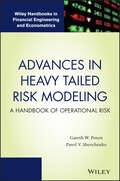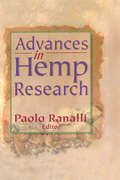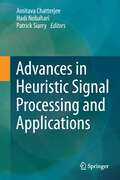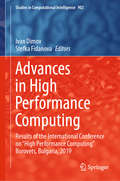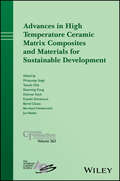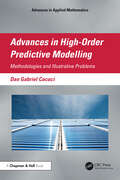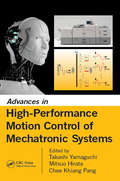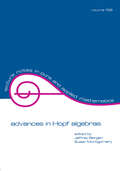- Table View
- List View
Advances in Happiness Research: A Comparative Perspective (Creative Economy)
by Toshiaki TachibanakiThis edited volume makes a contribution to the literature on happiness research by compiling studies based on cross-national research and from diverse academic disciplines. The book is distinctive in that it contains both theoretical and empirical analyses, investigating relationship between causes of happiness and economic behavior relating to employment, consumption, and saving. Most notably, it is one of the first studies in this subject area that analyzes micro data collected in Europe, US and Japan with information on respondents' attributes and their economic behavior, as well as in measuring inter-temporal happiness by principal factor analysis. Research findings in this volume shed new light on public policies for a number of areas such as employment, family, social welfare, urban and regional planning, and culture. The book draws on a collaborative research project between five institutions of higher education in France, UK, Germany, Switzerland, Belgium, and Japan that lasted for two years.
Advances in Haptics and Virtual Reality: Proceedings of 2023 International Conference on Haptics and Virtual Reality (Learning and Analytics in Intelligent Systems #37)
by Jianbo Su Xiuquan QiaoThis book collects selected papers from the 2023 International Conference on Haptics and Virtual Reality (ICHVR 2023), held during December 15–17, 2023. ICHVR 2023 is organized by Southeast University (SEU), Shanghai Jiao Tong University (SJTU) and co-organized by the International Association of Electrical, Electronic and Energy Engineering (IAEEEE). This book gathers together latest findings and insightful ideas from innovative academics and experts in the field of Haptics, Virtual Reality, Human–Computer Interaction, Computer Vision, Computer Arts, Mobile Intelligent Device and Artificial Intelligent Algorithm. This book serves as a valuable resource for staying up-to-date with the state of the art in Haptics and Virtual Reality and serves as a catalyst for further advancements and innovation in these fields, which will provide unique perspectives for readers consisting of professionals, scientists, practitioners, researchers, and graduate students.
Advances in Harmonic Analysis and Partial Differential Equations (Trends in Mathematics)
by Michael Ruzhansky Vladimir Georgiev Tohru Ozawa Jens WirthThis book originates from the session "Harmonic Analysis and Partial Differential Equations" held at the 12th ISAAC Congress in Aveiro, and provides a quick overview over recent advances in partial differential equations with a particular focus on the interplay between tools from harmonic analysis, functional inequalities and variational characterisations of solutions to particular non-linear PDEs. It can serve as a useful source of information to mathematicians, scientists and engineers. The volume contains contributions of authors from a variety of countries on a wide range of active research areas covering different aspects of partial differential equations interacting with harmonic analysis and provides a state-of-the-art overview over ongoing research in the field. It shows original research in full detail allowing researchers as well as students to grasp new aspects and broaden their understanding of the area.
Advances in Harmony Search, Soft Computing and Applications (Advances in Intelligent Systems and Computing #1063)
by Anupam Yadav Joong Hoon Kim Zong Woo Geem Donghwi Jung Do Guen YooThis book discusses various aspects of real-world applications of optimization algorithms, presenting insights from the 5th International Conference on Harmony Search, Soft Computing and Applications, held at Kunming, China on July 20–22, 2019. The book focuses on the recent advances in soft computing techniques such as harmony search, PSO and DE and their application to solve engineering problems. Presenting research on various real-world engineering problems concerning crowd evacuation strategies, adaptive learning systems, economic impact analysis, cyber-attack detection, urban drainage systems, water management models, feature selection and inventory systems, it is a valuable resource for researchers wanting a state-of-the-art overview of the latest advances in soft computing and related areas.
Advances in Hazardous Industrial Waste Treatment (Advances in Industrial and Hazardous Wastes Treatment)
by Lawrence K. Wang Yung-Tse Hung Nazih K. ShammasAs the global nature of pollution becomes increasingly obvious, successful hazardous waste treatment programs must take a total environmental control approach that encompasses all areas of pollution control. With its focus on new developments in innovative and alternative environmental technology, design criteria, effluent standards, managerial dec
Advances in Health Care Organization Theory
by Patrick D. Shay Stephen S. MickExplore the evolution of organization theory in the health caresector Advances in Health Care Organization Theory, 2nd Edition,introduces students in health administration to the fields oforganization theory and organizational behavior and theirapplication to the management of health care organizations. Thebook explores the major health care developments over the pastdecade and demonstrates the contribution of organization theory toa deeper understanding of the changes in the delivery system,including the historic passage of the Patient Protection andAffordable Care Act of 2010. Taking both a micro and macro view,editors Stephen S. Mick and Patrick D. Shay, collaborate with aroster of contributing experts to compile a comprehensive volumethat covers the latest in organization theory. Topics include:Institutional and neo-institutional theoryPatient-centered practices and organizational culturechangeDesign and implementation of patient-centered care managementteamsHospital-based clusters as new organizational structuresApplication of social network theory to health care
Advances in Health and Environment Safety: Select Proceedings of HSFEA 2016 (Springer Transactions in Civil and Environmental Engineering)
by S. M. Tauseef N. A. Siddiqui Kamal BansalThis book comprises selected papers on advances in the field of health and environment safety that were presented at the leading international conference on advances in the field of health, safety, fire, environment, allied sciences and engineering (HSFEA 2016). The book focuses on the latest developments in the field of health and environment safety, and highlights related opportunities and challenges. The book also presents methods that can be used to effectively monitor and measure climate change and global warming. Further, the contents of this work stress the importance of maintaining safety and healthy work environments that are free of occupational health hazards. This book will be of interest to researchers, professionals, and policy makers alike.
Advances in Healthcare Informatics and Analytics (Annals of Information Systems #19)
by Ashish Gupta Vimla L. Patel Robert A. GreenesThis important new volume presents recent research in healthcare information technology and analytics. Individual chapters look at such issues as the impact of technology failure on electronic prescribing behavior in primary care; attitudes toward electronic health records; a latent growth modeling approach to understanding lifestyle decisions based on patient historical data; designing an integrated surgical care delivery system using axiomatic design and petri net modeling; and failure in a dynamic decision environment, particularly in treating patients with a chronic disease. Other chapters look at such topics as the impact of information technology integration in integrated delivery systems; operations and supply chain control for inventory management in a health system pharmacy; decision-theoretic assistants based on contextual gesture recognition; evaluating emergency response medical information systems; clinical decision support in critical care; virtual worlds in healthcare; and natural language processing for understanding contraceptive use at the VA.
Advances in Heart Valve Biomechanics: Valvular Physiology, Mechanobiology, and Bioengineering
by Michael S. Sacks Jun LiaoThis book covers the latest research development in heart valve biomechanics and bioengineering, with an emphasis on novel experimentation, computational simulation, and applications in heart valve bioengineering. The most current research accomplishments are covered in detail, including novel concepts in valvular viscoelasticity, fibril/molecular mechanisms of tissue behavior, fibril kinematics-based constitutive models, mechano-interaction of valvular interstitial and endothelial cells, biomechanical behavior of acellular valves and tissue engineered valves, novel bioreactor designs, biomechanics of transcatheter valves, and 3D heart valve printing. This is an ideal book for biomedical engineers, biomechanics, surgeons, clinicians, business managers in the biomedical industry, graduate and undergraduate students studying biomedical engineering, and medical students.
Advances in Heat Pump-Assisted Drying Technology (Advances in Drying Science and Technology #Vol. 1)
by Vasile MineaDrying of solids is one of the most common, complex, and energy-intensive industrial processes. Conventional dryers offer limited opportunities to increase energy efficiency. Heat pump dryers are more energy and cost effective, as they can recycle drying thermal energy and reduce CO2, particulate, and VOC emissions due to drying. This book provides an introduction to the technology and current best practices and aims to increase the successful industrial implementation of heat pump- assisted dryers. It enables the reader to engage confidently with the technology and provides a wealth of information on theories, current practices, and future directions of the technology. It emphasizes several new design concepts and operating and control strategies, which can be applied to improve the economic and environmental efficiency of the drying process. It answers questions about risks, advantages vs. disadvantages, and impediments and offers solutions to current problems. Discusses heat pump technology in general and its present and future challenges. Describes interesting and promising innovations in drying food, agricultural, and wood products with various heat pump technologies. Treats several technical aspects, from modeling and simulation of drying processes to industrial applications. Emphasizes new design concepts and operating and control strategies to improve the efficiency of the drying process.
Advances in Heat Transfer Augmentation Techniques in Single-Phase Flows
by Wei Wang Varun Goel Bengt SundenAugmentation of heat transfer is important in energy conservation and developing sustainable energy systems. This book provides the science necessary to understand the basics of heat transfer augmentation in single-phase engineering systems. It considers theory and practice including computational and experimental procedures, evaluation techniques for performance, and new trends. Several applications of augmentation methods like surface modification, introduction of vortex flow and impinging jets, opportunities of ultrasound and magnetic fields, pulsatile flows, heat exchangers, and nanofluids are provided. Details of basic phenomena and mechanisms are highlighted.Key features: Provides the fundamental science needed to understand and further develop heat transfer augmentation for future energy systems Give examples of how ultrasound and magnetic fields, vortex flow, impinging jets, surface modification and nanofluids can augment heat transfer Considers basic issues of computational and experimental methods for analysis, design, and evaluation of efficient and sustainable heat transfer It is an ideal reference text for graduate students and academic researchers working in the fields of mechanical, aerospace, industrial, manufacturing, and chemical engineering.
Advances in Heat Transfer Enhancement
by Sujoy Kumar Saha Manvendra Tiwari Bengt Sundén Zan WuThis Brief addresses the phenomena of heat transfer enhancement. A companion edition in the SpringerBrief Subseries on Thermal Engineering and Applied Science to three other monographs including "Critical Heat Flux in Flow Boiling in Microchannels," this volume is idea for professionals, researchers, and graduate students concerned with electronic cooling.
Advances in Heat Transfer Unit Operations: Baking and Freezing in Bread Making (Contemporary Food Engineering #40)
by Georgina Calderón-Domínguez, Gustavo F. Gutiérrez-López and Keshavan NiranjanAdvances in Heat Transfer Unit Operations: Baking and Freezing in Bread Making explains the latest understanding of heat transfer phenomena involved in the baking and freezing of bread and describes the most recent advanced techniques used to produce higher quality bread with a longer shelf life. Heat transfer phenomena occur during key bread-making stages (cold storage, resting, and fermentation) in which temperature and amount of heat transfer must be carefully controlled. This book combines the engineering and technological aspects of heat transfer operations and discusses how these operations interact with the bread making process; the book also discusses how baking and freezing influence the product quality. Divided into fourteen chapters, the book covers the basics of heat and mass transfer, fluid dynamics, and surface phenomena in bread-making industrial operations, mathematical modelling in porous systems, the estimation of thermo-physical properties related to bread making, design of equipment, and industrial applications.
Advances in Heat Transfer and Fluid Dynamics: Select Proceedings of AHTFD 2022 (Lecture Notes in Mechanical Engineering)
by Nadeem Hasan Mohammad Altamush Siddiqui Andallib TariqThis book comprises select proceedings of the 1st International Conference on Heat Transfer and Fluid Dynamics (AHTFD 22). It covers latest research trends and development in diverse areas like, aerodynamics, complex fluid phenomenon, turbulence, flow control, thermal management, green buildings, micro-scale transport phenomena in biological systems, renewable energy, power generation, combustion and related applications in heat transfer and fluid dynamics, among others. The book is a valuable resource for researchers and professionals working in the various areas of mechanical engineering.
Advances in Heat Transfer and Thermal Engineering: Proceedings of 16th UK Heat Transfer Conference (UKHTC2019)
by Chuang Wen Yuying YanThis book gathers selected papers from the 16th UK Heat Transfer Conference (UKHTC2019), which is organised every two years under the aegis of the UK National Heat Transfer Committee. It is the premier forum in the UK for the local and international heat transfer community to meet, disseminate ongoing work, and discuss the latest advances in the heat transfer field. Given the range of topics discussed, these proceedings offer a valuable asset for engineering researchers and postgraduate students alike.
Advances in Heavy Tailed Risk Modeling
by Pavel V. Shevchenko Gareth W. PetersA cutting-edge guide for the theories, applications, and statistical methodologies essential to heavy tailed risk modeling Focusing on the quantitative aspects of heavy tailed loss processes in operational risk and relevant insurance analytics, Advances in Heavy Tailed Risk Modeling: A Handbook of Operational Risk presents comprehensive coverage of the latest research on the theories and applications in risk measurement and modeling techniques. Featuring a unique balance of mathematical and statistical perspectives, the handbook begins by introducing the motivation for heavy tailed risk processes in high consequence low frequency loss modeling. With a companion, Fundamental Aspects of Operational Risk and Insurance Analytics: A Handbook of Operational Risk, the book provides a complete framework for all aspects of operational risk management and includes: Clear coverage on advanced topics such as splice loss models, extreme value theory, heavy tailed closed form loss distributional approach models, flexible heavy tailed risk models, risk measures, and higher order asymptotic approximations of risk measures for capital estimation An exploration of the characterization and estimation of risk and insurance modelling, which includes sub-exponential models, alpha-stable models, and tempered alpha stable models An extended discussion of the core concepts of risk measurement and capital estimation as well as the details on numerical approaches to evaluation of heavy tailed loss process model capital estimates Numerous detailed examples of real-world methods and practices of operational risk modeling used by both financial and non-financial institutions Advances in Heavy Tailed Risk Modeling: A Handbook of Operational Risk is an excellent reference for risk management practitioners, quantitative analysts, financial engineers, and risk managers. The book is also a useful handbook for graduate-level courses on heavy tailed processes, advanced risk management, and actuarial science.
Advances in Hemophilia Treatment: From Genetics to Joint Health
by E. Carlos Rodríguez-MerchánThis book offers a comprehensive and state of the art overview of hemophilia management by reviewing all most recent advances and cutting edge information in this fast evolving field. As hemophilia patients are often affected by joint problems it also provides clear guidance on the surgical treatment of musculo-skeletal manifestations. The first part is devoted to the disease’s pathophysiology (differentiating hemophilia A and B), genetics, pharmacotherapy – including replacement and non-replacement therapy – and gene therapy, as well as quality of life issues – also related to hemophilia carriers. The second part is then focused on joint problems, ranging from joint health assessment and pain control to surgical treatment of acute hemarthrosis and hemophilic arthropathy, i.e. radiosynovectomy, total joint arthroplasty and arthroscopic joint debridement.Written by experts drawn from leading institutions involved in treatment of hemophilia and related joint problems, this book offers a valuable resource to hematologists, orthopedic surgeons, rehabilitation physicians, radiologists, and pharmacy researchers.
Advances in Hemp Research
by Paoli RanalliOffering up-to-date information on the uses and composition of the plant, Advances in Hemp Research provides growers, researchers, manufacturers, and suppliers with methods and data for the processing and cultivation of hemp for textile and paper products. You will learn how recent advances in germplasm resources, breeding methods, and the improvem
Advances in Heuristic Signal Processing and Applications
by Patrick Siarry Hadi Nobahari Amitava ChatterjeeThere have been significant developments in the design and application of algorithms for both one-dimensional signal processing and multidimensional signal processing, namely image and video processing, with the recent focus changing from a step-by-step procedure of designing the algorithm first and following up with in-depth analysis and performance improvement to instead applying heuristic-based methods to solve signal-processing problems. In this book the contributing authors demonstrate both general-purpose algorithms and those aimed at solving specialized application problems, with a special emphasis on heuristic iterative optimization methods employing modern evolutionary and swarm intelligence based techniques. The applications considered are in domains such as communications engineering, estimation and tracking, digital filter design, wireless sensor networks, bioelectric signal classification, image denoising, and image feature tracking. The book presents interesting, state-of-the-art methodologies for solving real-world problems and it is a suitable reference for researchers and engineers in the areas of heuristics and signal processing.
Advances in High Performance Computing: Results of the International Conference on “High Performance Computing” Borovets, Bulgaria, 2019 (Studies in Computational Intelligence #902)
by Stefka Fidanova Ivan DimovEvery day we need to solve large problems for which supercomputers are needed. High performance computing (HPC) is a paradigm that allows to efficiently implement large-scale computational tasks on powerful supercomputers unthinkable without optimization. We try to minimize our effort and to maximize the achieved profit. Many challenging real world problems arising in engineering, economics, medicine and other areas can be formulated as large-scale computational tasks. The volume is a comprehensive collection of extended contributions from the High performance computing conference held in Borovets, Bulgaria, September 2019. This book presents recent advances in high performance computing. The topics of interest included into this volume are: HP software tools, Parallel Algorithms and Scalability, HPC in Big Data analytics, Modelling, Simulation & Optimization in a Data Rich Environment, Advanced numerical methods for HPC, Hybrid parallel or distributed algorithms. The volume is focused on important large-scale applications like Environmental and Climate Modeling, Computational Chemistry and Heuristic Algorithms.
Advances in High Temperature Ceramic Matrix Composites and Materials for Sustainable Development: Ceramic Transactions Volume 263
by Mrityunjay Singh Tatsuki Ohji Kiyoshi Shimamura Jun Akedo Bernd Clauss Bernhard Heidenreich Dietmar Koch Shaoming DongGlobal population growth and tremendous economic development has brought us to the crossroads of long-term sustainability and risk of irreversible changes in the ecosystem. Energy efficient and ecofriendly technologies and systems are critically needed for further growth and sustainable development. While ceramic matrix composites were originally developed to overcome problems associated with the brittle nature of monolithic ceramics, today the composites can be tailored for customized purposes and offer energy efficient and ecofriendly applications, including aerospace, ground transportation, and power generation systems. The 9th International Conference on High Temperature Ceramic Matrix Composites (HTCMC 9) was held in Toronto, Canada, June 26-30, 2016 to discuss challenges and opportunities in manufacturing, commercialization, and applications for these important material systems. The Global Forum on Advanced Materials and Technologies for Sustainable Development (GFMAT 2016) was held in conjunction with HTCMC 9 to address key issues, challenges, and opportunities in a variety of advanced materials and technologies that are critically needed for sustainable societal development. This Ceramic Transactions volume contains a collection of peer reviewed papers from the 16 below symposia that were submitted from these two conferences Design and Development of Advanced Ceramic Fibers, Interfaces, and Interphases in Composites- A Symposium in Honor of Professor Roger Naslain Innovative Design, Advanced Processing, and Manufacturing Technologies Materials for Extreme Environments: Ultrahigh Temperature Ceramics (UHTCs) and Nano-laminated Ternary Carbides and Nitrides (MAX Phases) Polymer Derived Ceramics and Composites Advanced Thermal and Environmental Barrier Coatings: Processing, Properties, and Applications Thermomechanical Behavior and Performance of Composites Ceramic Integration and Additive Manufacturing Technologies Component Testing and Evaluation of Composites CMC Applications in Transportation and Industrial Systems Powder Processing Innovation and Technologies for Advanced Materials and Sustainable Development Novel, Green, and Strategic Processing and Manufacturing Technologies Ceramics for Sustainable Infrastructure: Geopolymers and Sustainable Composites Advanced Materials, Technologies, and Devices for Electro-optical and Medical Applications Porous Ceramics for Advanced Applications Through Innovative Processing Multifunctional Coatings for Sustainable Energy and Environmental Applications
Advances in High-Order Predictive Modeling: Methodologies and Illustrative Problems (Advances in Applied Mathematics)
by Dan Gabriel CacuciContinuing the author’s previous work on modeling, this book presents the most recent advances in high-order predictive modeling. The author begins with the mathematical framework of the 2nd-BERRU-PM methodology, an acronym that designates the “second-order best-estimate with reduced uncertainties (2nd-BERRU) predictive modeling (PM).” The 2nd-BERRU-PM methodology is fundamentally anchored in physics-based principles stemming from thermodynamics (maximum entropy principle) and information theory, being formulated in the most inclusive possible phase-space, namely the combined phase-space of computed and measured parameters and responses.The 2nd-BERRU-PM methodology provides second-order output (means and variances) but can incorporate, as input, arbitrarily high-order sensitivities of responses with respect to model parameters, as well as arbitrarily high-order moments of the initial distribution of uncertain model parameters, in order to predict best-estimate mean values for the model responses (i.e., results of interest) and calibrated model parameters, along with reduced predicted variances and covariances for these predicted responses and parameters.
Advances in High-Performance Motion Control of Mechatronic Systems
by Chee Khiang Pang Takashi Yamaguchi Mitsuo HirataMechatronic systems are used in a range of consumer products from large-scale braking systems in vehicular agents to small-scale integrated sensors in mobile phones. To keep pace in the competitive consumer electronics industry, companies need to continuously improve servo evaluation and position control of these mechatronic systems. Advances in High-Performance Motion Control of Mechatronic Systems covers advanced control topics for mechatronic applications. In particular, the book examines control systems design for ultra-fast and ultra-precise positioning of mechanical actuators in mechatronic systems. The book systematically describes motion control design methods for trajectory design, sampled-data precise positioning, transient control using switching control, and dual-stage actuator control. Each method is described in detail, from theoretical aspects to examples of actual industry applications including hard disk drives, optical disk drives, galvano scanners, personal mobility robots, and more. This helps readers better understand how to translate control theories and algorithms from theory to design and implementation in realistic engineering systems. The book also identifies important research directions and advanced control techniques that may provide solutions for the next generation of high-performance mechatronics. Bridging research and industry, this book presents state-of-the-art control design methodologies that are widely applicable to industries such as manufacturing, robotics, home appliances, automobiles, printers, and optical drives. It guides readers toward more effective solutions for high-performance mechatronic systems in their own products.
Advances in Historical Orthography, c. 1500–1800
by Marco CondorelliThe early modern period is a key historical era for the standardisation of languages in Europe, in which orthographies played an important role. This book traces the development of European spelling systems in the early modern era, and is unique in bringing together several strands of historical research, across a diverse range of Germanic, Romance and Slavic languages, including Polish, German, French, Spanish, Lithuanian, Czech, Croatian and English. Whilst each chapter includes a case study on a particular language or script, the volume in general follows a broad thread of discussion based on models and methods relevant to many languages, showing how empirical approaches can be applied across languages to enrich the field of historical orthography as a whole. The first volume to diachronically explore the standardization of spelling systems from a cross-linguistic perspective, this is an invaluable resource for specialists and those interested in historical European studies more broadly.
Advances in Hopf Algebras (Lecture Notes In Pure And Applied Mathematics Ser.)
by Susan Montgomery Jeffrey Bergen"This remarkable reference covers topics such as quantum groups, Hopf Galois theory, actions and coactions of Hopf algebras, smash and crossed products, and the structure of cosemisimple Hopf algebras. "

